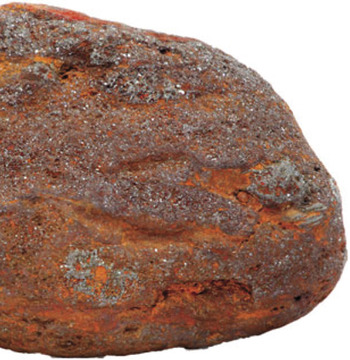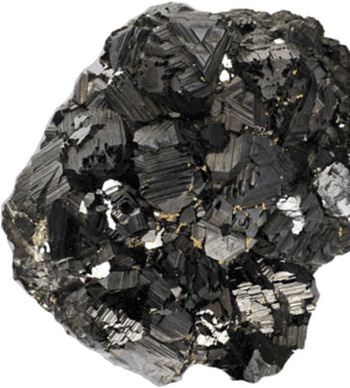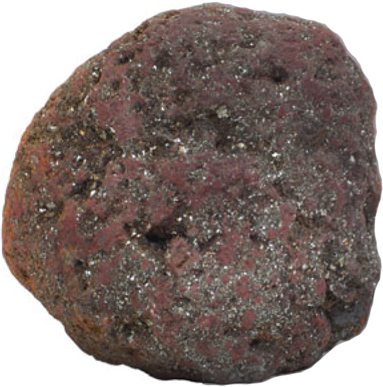I used to own a lodestone—a magnetic mineral. I don’t have it anymore because I lent it to someone and can’t remember who borrowed it. After it went missing, I realized how much I appreciated that hunk of earth. It was craggily, softball-sized, and seemed out of place on my organized desk. To make it look more appropriate for an office setting, I stuck a few paper clips on its side, which teased gravity. I really enjoyed looking at that old rock.
One night, I was preparing notes for the following day’s lecture on magnetism and was looking for a neat fact or two to share with my students. I hoped to make the topic enticing, particularly to the apprehensive liberal arts majors, so I dove into a few textbooks and began hunting. Staring at the empty space where my lodestone formerly sat, I was inspired to learn more about it. However, it was late, and I had to choose between finishing my notes quickly or following my curiosity about magnets. My curiosity won.
I dug frantically for facts. First, I scanned a large stack of textbooks, but they didn’t offer much. In fact, they furnished no history at all and started the topic of magnetism with a description of quantum mechanics. I knew that would not engender warm feelings from my students, so I kept digging.

I dashed downstairs to the building’s library and combed a pile of recent papers on lodestones and a mountain of rare, old magnetism books. The papers provided a few intriguing facts, like birds use magnets to navigate. Turns out that birds have special cells tuned to the magnetic field of the earth that guide them. Sea turtles do too. I knew my students would enjoy these nuggets, so I unearthed more. There are some bacteria that align along a magnetic field. Embedded in their cell membranes are tiny iron crystals that cause them to move with a magnet—whether they want to or not. Another gem.

Hours passed and a long night of writing waited. But, I had one more question: “Where do lodestones come from?” That seemed like a simple question with a simple answer. It wasn’t.
I uncovered a paper from the 1930s that stated lightning created lodestones. That information struck me hard. But, my curiosity had to wait. It was very late and work beckoned. That night, I wrote my notes thinking about lodestones and lightning.
A few weeks later, on a cold December evening when the snow left me little opportunity to do anything else, I went back to this lodestone bombshell. Perplexed, I wanted to find out if lightning indeed made lodestones. So I spent the evening sending emails to scientists who could confirm this.
A few days later, I received a reply from Peter Wasilewski, a retired NASA scientist. He returned from giving lectures on a cruise and had time to speak about his work with lightning. I was thrilled. Now, I was going to get to the bottom of this.
I reached him by phone and asked him about lodestones. In a matter-of-fact way, Wasilewski told me that he made magnets using lightning. It became clear from the beginning that I was much more excited about this conversation than he was. That made sense—he worked with lightning for a living. Everything else was boring in comparison.
Wasilewski studied what he calls nature’s permanent magnet—the lodestone. Lodestones served civilization for thousands of years, since the beginning with the early compasses in China, which allowed us to reach new corners of the earth. And the unusual origin of lodestones was presumed decades ago. The first clue that these stones were strange hinged on the fact that they are only found on the surface of the earth. Magnetic lodestones are not found in mines.
Wasilewski went on to tell me that a lodestone, or magnetite, a bluish mineral, is not a magnet on its own. It must be oxidized to include a bit of maghemite, a brownish substance, and then it is converted to a magnet with lightning. “The thing about the lightning bolt, besides being magical, is that it has a magnetic field associated with it,” he said. Lightning changes the stone by providing a mammoth magnetic field. One can demonstrate this by rubbing a needle with a magnet. After rubbing, the needle temporarily turns into a magnet too. Lightning and lodestones undergo a similar process but on a larger, supernatural scale. The magnetic field around the lightning bolt permanently transforms lodestones into magnets.
So how do you coax lightning to strike a stone? Ben Franklin knew. In colonial times, folks understood how to draw lightning—or “electric fire”—using pointed metal lightning rods on top of buildings. However, Franklin took it one step further. Instead of waiting for lightning to come to him, he went to it. He flew a kite on a stormy night and cast a line for lightning using a metal key for bait. It worked. The electricity struck the kite and went down the string. And, while this story was believed to be a tall tale, Franklin actually described this experiment in a letter to Peter Collinson that was published in Philosophical Transactions in 1751.
Wasilewski created lodestones using lightning in much the same way as Ben Franklin, but with much more expensive tools. First, Wasilewski went to where lots of lightning occurs. He conducted his experiments at the Langmuir Laboratory on the top of South Baldy Mountain near Socorro, N.M. (New Mexico and Florida in the summer months are hotspots for lightning strikes.) Then, he needed a better “kite” and replaced Franklin’s contraption with a small bottle rocket that he launched into storm clouds. Attached to this rocket was a three-mile-long metal wire fastened to a plastic box. A bed of sand covered the bottom of the box, and the soon-to-be-zapped mineral sat on top. “All these parts you can get from your local hardware store,” said Wasilewski. “Except the rocket,” I replied.
The experiment happened in a flash and what remained was charred or burnt. “There is so much energy,” said Wasilewski, “the sand melts.” In microseconds, lightning heats everything to over 2900°F. And the accompanying magnetic field turns the mineral into a magnet. Before the rock was struck, paper clips passed by without a peep. Now, it is a magnetic lodestone and attracts paper clips just like the one that sat on my desk long ago. I miss that old stone. I need to get another one, maybe for Christmas, and this time I’ll write down the name of the person who borrows it, if I dare to lend it out at all.
Did you know?
Facts about lodestones
The magnetic properties of natural ferric ferrite (Fe3O4) stones (lodestones) were first described by Greek philosophers in 600 BC.
The name lodestone comes from Middle English and means “coarse stone” or “leading stone.” The word magnet may have come from lodestones found in Magnesia, a region in Greece.

Early civilizations discovered that striking magnetite “lodestone” against pieces of iron would magnetize the iron. This magnetized iron was used to make the first compasses during China's Han dynasty.
Magnetite lodestones are one of only two minerals that have been found to be naturally magnetized on earth. What is the other one?

Lodestones were once believed to possess magical properties of various kinds. If one was ill, the stone would be held in the hands and shaken well. It was said to cure wounds, snakebites, weak eyes, headaches, and defective hearing.


